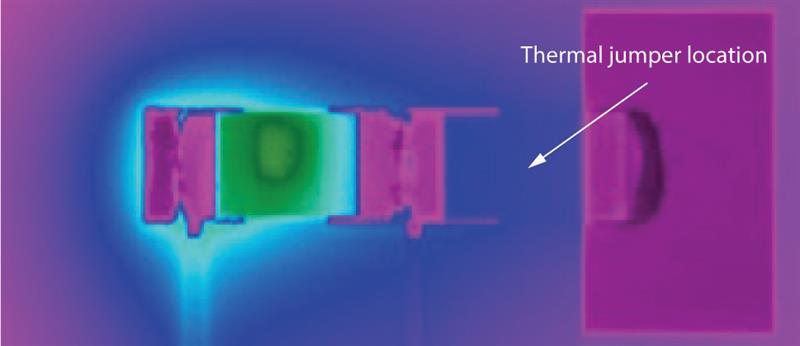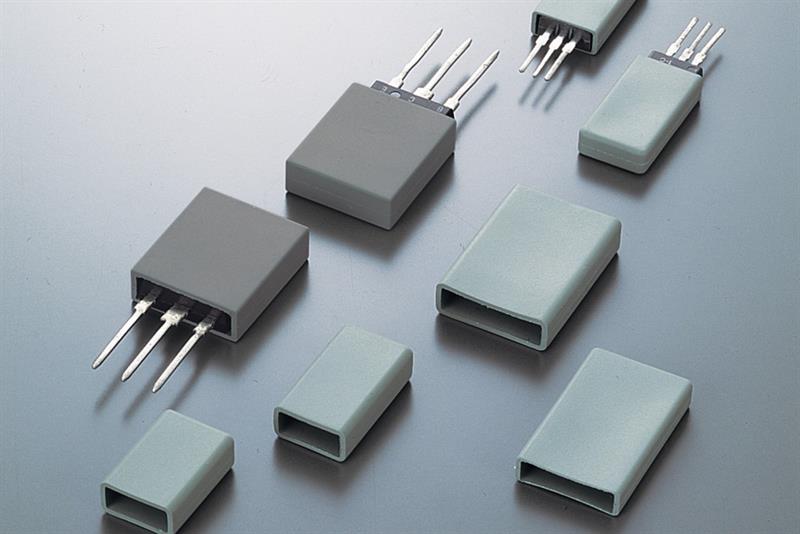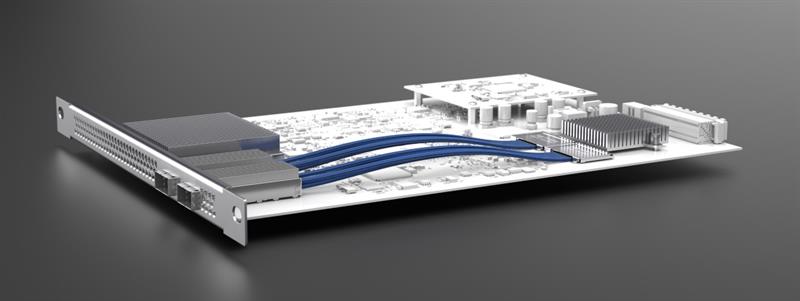Miniaturisation places demands on circuit boards and other system space, as densely packed components vie not just for real estate but for the right operating conditions as heat levels rise.
Materials and packaging are increasingly important in the design of devices for power supplies, power converters, RF amplifiers, synthesisers, switch mode power supplies (SMPS), diodes and filters.
Vishay Thin Film uses aluminium nitride substrates in both tin / lead (SnPb) and lead (Pb)-free wraparound termination styles for its ThermaWick Thermal Jumper surface mount chips. They provide an electrically isolated thermal, conductive path to a ground plane, chassis or heat sink while maintaining electrical isolation and have a low capacitance that makes them particularly suited to high-frequency and thermal ladder applications, says the company.
Thermal conductivity
In designs where components generate heat but cannot be grounded, the surface mount chips can be used to remove that heat to protect the circuit and improve the reliability of the end product. They have a high thermal conductivity AIN substrate, delivering 170W/m°K and have electrically isolated terminations and low capacitance to increase the power handling capabilities or extend the operating lifetime of associated components.
In a dramatic illustration, the company shows how the ThermaWick THJP1206 thermal jumper reduces surface temperature by 36% (Figure 1).

Figure 1: Vishay’s ThermaWick THJP1206 thermal jumper reduces surface temperature by 36%
A ceramic resistor chip was mounted on an FR4 card with a copper heat sink and power was supplied to the device. A FLIR SC645 thermal imaging system captured the thermal conductivity under ambient conditions captured the surface temperature of the device stabilise at approximately 150°C. A thermal jumper was introduced, connecting the ceramic resistor
to the heat sink and retested at the same power level. The thermal imaging system showed the temperature had reduced to 95.5°C.
Vishay has published figures for the different case sizes, recording the best parameters of thermal conductance achievable for the 0606 (66mW°C), the 0805 (77mW/°C) and the 1225 (259mW/°C).
The ThermaWick Thermal Jumper surface mount chip is available in six surface mount case sizes and custom sizes are available on request.
A cap on heat costs
Fujipoly offers a range of Sarcon thermal interface caps which can be slid over transistors and other heat-generating components on the board. The company offers a selection of sizes of box-shaped caps to fit standard components and also has a custom service to produce caps to exact specifications. The cap dissipates unwanted heat away from the device to the surrounding areas or nearby heatsinks. The caps (Figure 2) are also available in a choice of thickness, depending on the application’s power and cooling requirements, from 0.3 to 0.85mm. Thermal conductivity ranges from 1.1 to 1.7W/m°K and corresponding thermal resistance of 0.42 to 1.35°C-in2/W. The covers also protect against vibration and impact and provide electrical insulation for added reliability.

Networking demands
PCB materials and designs are increasingly under review for data services, as transceiver performance pushes onward and upward, running at 56 to 112Gb/s pulse-amplitude modulation 4-Level (PAM4), from the edge to the cloud. This consumes more power than non-return to zero (NRZ) transceivers because more advanced equalisation is needed for operation.
A group of companies, including Broadcom, Cisco, II-VI, Intel, Juniper Networks, Marvell, Molex and Samtec are part of the Multi Source Agreement (MSA) group. This association of over 50 companies develops and promotes hardware specifications to ensure signal integrity and thermal performance in high-speed, double-density quad form factor pluggable modules to support 800Gb/s connectivity.
The MSA group has announced the Quad Small Form Factor Pluggable Double Density 800 (QSFP-DD800) transceiver form factor 1.0 specification, for modules which builds on QSFP-DD 5.0. The specification optimises transceiver pads to improve signal integrity for 100Gb/s per lane modules, without affecting backwards-compatibility. It defines a module, connector, stacked connector and a hybrid connector (a BiPass or Flyover version, which has raised ports) to minimise or eliminate signal losses on a traditional PCB (Figure 3).

The specification is backwards-compatible with QSFP-DD, QSFP28 AND QSFP+ modules and cables. The MSA says that it has been introduced to address 25.6Tb/s systems which support dense 100GbE or 400GbE interfaces.
Thermal technology
TE Connectivity has introduced thermal bridge technology, available in its cage assemblies for PCB connectivity.
It is claimed to provide up to two times the thermal resistance of traditional thermal technologies such as gap pads or thermal pads which require a spring mechanism or heavy force to compress the material for effective heat transfer. The company also argues that gap and thermal pads may degrade over time, meaning that more pressure has to be exerted to maintain performance levels.
Its thermal bridge technology is integrated into the company’s 2358986-1 SFP+ cage assembly, the 2354751-1 (QSFP-DD form factor), and the 2359309-1, 2354935-1 and 2355519-1 QSFP28 form factor cage assemblies.
In this thermal bridge, interleaved, parallel plates allow heat to pass from the I/O module to the cooling area.
Mechanical springs provide the interface force. The spring loaded thermal bridge which offers 1.0mm (typical) z-axis compression and the dual-spring design tilts to conform in the y-axis. Individual plate actuation allows for surface conformability in the x-axis, says the company and there are three points of contact per plate for a total of over 150 pints of contact to an adjacent surface.
The use of a spring also increases reliability, says the company, as the elastic compression design is resistant to set and relaxation over time.
Rather than compression, the thermal bridge has to make contact with an I/O module and a cold plate or ganged heatsink to transfer the heat.
The thermal bridge has a near-zero plate gap for compressibility and thermal transfer, says TE. It is supplied, pre-assembled on I/O cage.
Packaging
Dense board design and its heat transference has also influenced the design of Texas Instruments’ TPSM53604, a DC/DC buck module in a quad flat no-lead (QFN) package.
It has a single thermal pad to optimise heat transfer, which allows some flexibility in board mounting and layout. The QFN package footprint is designed in such a way that 42% of it touches the board, to increase the efficiency of heat dissipation at high ambient temperature compared to equivalent ball-grid array (BGA) packages, says the company.
The 36V, 4A power module’s footprint is just 5.0 x 5.0mm which contributes to a reduction in size of the final power supply; it also reduces the power loss by 50% compared to similar modules, claims TI.
It operates at high temperatures, up to 105°C for efficient thermal management in harsh environments such as factory automation and control, the power grid infrastructure, test and measurement equipment, industrial transport, aerospace and defence projects. The company believes that the total area of 85mm2 for a single-sided layout is the smallest footprint for common 24V, 4A industrial applications, where space constraints can also influence design.
Other design features which meet the industrial market’s demanding environment is that its integrated MOSFETs have low drain-source on-resistance (RDS(on)) for conversion efficiency of 90% at 24 to 5V. For EMI performance, the power modules uses integrated high-frequency bypass capacitors and no bond wires.













